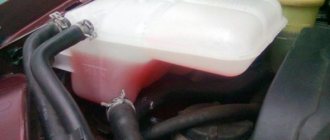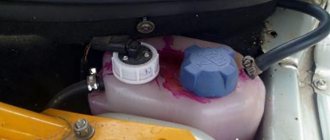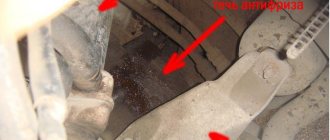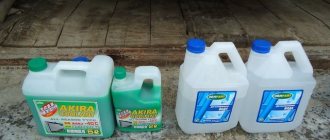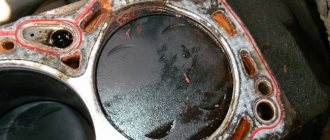One of the common problems that arise with the engine cooling system is a fluid leak. Due to low levels of antifreeze, problems may occur with both the engine itself and parts of the cooling system. Therefore, the fluid level in the expansion tank must be regularly monitored and not allowed to drop below MIN. You can determine that antifreeze is running out by the following signs:
- The coolant level is constantly decreasing;
- the heater stops working;
- The engine temperature becomes higher than normal.
A minimal increase or decrease in the coolant level in the expansion tank is considered normal. However, if antifreeze needs to be topped up periodically, then you need to deal with the problem that has arisen.
Engine radiator leaking
The most common reason why coolant leaves the system is damage to the main radiator of the cooling system. The malfunction can be diagnosed by smudges on the unit body or a puddle under the car after parking. Damage to the heat exchanger can be caused by the following factors:
- exposure to corrosion as a result of long-term use;
- hit by a stone flying out from under the wheels.
The design of the radiator consists of many honeycombs through which coolant circulates. Even the slightest damage to one of them will lead to leakage. To diagnose a breakdown, you will need to remove the heat exchanger from the car, assess the nature of the damage and try to restore the seal by soldering or argon welding. If you do not take any action to eliminate the leak, the engine will overheat, which sooner or later will lead to serious consequences and expensive repairs.
Malfunction of the radiator or heater tap
Sometimes there is a leak in the interior heater core. The problem manifests itself as a puddle of coolant under the front passenger's carpet, as well as a foggy windshield. In this case, the radiator will have to be removed from the car to identify the damaged area and carry out similar measures as with the main radiator.
Depending on the make and model of the vehicle, removing the heat exchanger may require disassembling the instrument panel.
If the leak is caused by a leak in the faucet, drops of antifreeze will be visible on it. The device, as a rule, cannot be repaired and must be replaced with a new part. Sometimes antifreeze begins to leak due to aging of the gaskets between the faucet and the radiator. In this case, they are simply replaced with new ones.
Defects in hoses, pipes and pipes
A large number of pipes made of rubber are used as connecting elements in the engine cooling system. Due to constant exposure to an aggressive environment, temperature changes and vibrations, rubber becomes unusable over time and cracks appear. The formation of damage to the pipes clearly leads to a leak of antifreeze as the engine warms up and the pressure in the system increases. Worn hoses must only be replaced. Any tricks and attempts to patch and restore their integrity will lead to leakage and loss of antifreeze. If the malfunction can be eliminated, it will only be for a short time.
The tightness can be compromised not only by damage or wear of rubber pipes, but also by metal tubes, which are also present in the cooling system. These elements corrode and burst over time. Therefore, if a leak is detected, the tubes must be replaced.
Pump failure
Sometimes the reason for coolant leakage is wear of the water pump seals: gasket and oil seal. The gasket most often fails due to long life or as a result of damage, for example, if the pump was over-tightened. Confirmation of pump leakage is a wet engine where the pump is installed, as well as the presence of drops of coolant on the mechanism housing from below. If the malfunction is caused by wear of the gasket, then it is enough to replace it or use a sealant gasket. If the oil seal fails, repairs will have to be made if the pump design allows this. Otherwise, the unit must be replaced.
Thermostat
As a result of prolonged use, the thermostat housing begins to leak over time. This unit is responsible for regulating the flow of coolant by opening and closing a valve located inside. In case of any breakdown, the device must only be replaced.
Expansion tank defects
The expansion tank body is usually made of plastic. Over time, it can either burst or rub against body elements, which depends on the installation location. Such a malfunction cannot be ignored, since the container or its lower part will be wet. If the tank is damaged, you can try to solder it, but it is better to replace it with a new one, since soldering will only temporarily eliminate the leak. In addition to the tank, the lid may fail, since a valve is mounted inside it, designed to maintain a certain pressure in the system. If there is a problem with the valve, antifreeze will splash out after the engine warms up. In this case, the cover needs to be diagnosed or replaced.
When to change coolant
Drain plug
There are several situations that will require you to carry out the procedure for replacing the coolant.
- The color of the coolant has changed. The liquid may take on a rusty color. This indicates the need for replacement.
- An oil film has formed on the surface of the cooler.
- Antifreeze often bubbles in the expansion tank of a VAZ 2110. Moreover, there were no prerequisites for such a phenomenon. The Ten is a car for good speeds, because when driving at low speeds, the antifreeze in the expansion tank on the VAZ 2110 often boils. This is because the cooling fan does not turn on.
- A coolant that is no longer suitable for further use may also boil, the composition of which has changed significantly since it was poured into the expansion tank.
- Antifreeze is leaking somewhere from the expansion tank on a VAZ 2110. The situation is common, but it cannot be solved by adding or replacing coolant. It is necessary to find where the antifreeze is leaking from the expansion tank of the VAZ 2110. Usually the leak is found on the clamps, although it would not be a bad idea to check the entire system.
- The coolant level may be normal, during operation it does not emit antifreeze from the expansion tank of the VAZ 2110, the color is normal, but still the boiling process occurs quickly. Most likely, the reason lies in the airlock.
Causes of malfunctions
The most common reason why antifreeze is knocked out of the expansion tank is that the cap bypass valve is jammed or dirty. In this case, the air compressed by pressure does not find a way out, and the antifreeze is kicked out through the weakest point in the structure. Usually this is a thread on a plug or a pipe joint. It also happens that the lid valve remains open. Then the system is constantly in contact with the atmosphere, which reduces the minimum boiling point of the liquid, and more steam is formed in the nozzles. It comes out through a hole in the plug, and the antifreeze level is constantly, albeit slowly, decreasing. The main difficulty here is that leaks are not visible.
Problems may also have other causes:
- antifreeze may leak through a crack in the expansion tank, which appeared due to a malfunction of the cap valve. When all connections are tight, the compressed air finds no outlet and literally bursts the container;
- if the pump (water pump) seal is faulty, liquid will flow out and fall on the pulley and timing belt and splash the cylinder block;
- a leak may occur in the cooling radiator and stove due to mechanical damage or corrosion;
- The gasket between the head and the cylinder block can burn out when microcracks appear into which gases leak. Over time, the cracks expand and connect chambers with water and oil channels. In this case, process fluids are mixed and they enter the cylinders.
The car owner may not be aware of the problem, but he should be confused by the fact that antifreeze constantly disappears from the expansion tank, and it has to be topped up almost every day. But it is important to understand that if the reason is, for example, a gasket breakdown, then you should not hesitate. Without timely diagnosis and repair, the engine may fail.
Hidden problems
You have looked at everything and everyone, there are no leaks anywhere, all the hoses and clamps are in order, but the antifreeze or antifreeze goes away, “even if you crack”! The fact is that there are not only open leaks, but also so-called hidden ones, and they are much more dangerous.
A car engine is not a cast structure - there is a separate engine block and cylinder head. There is a gasket between these two parts, this is mandatory, it is high-temperature (can maintain high positive values), and it is also a sealing link. In the engine block, as well as in the cylinder head, there are channels through which antifreeze (antifreeze) passes, cooling the metal, thus the “entire engine” is at an operating temperature that does not exceed 90 - 100 degrees Celsius, without this fluid the engine would very quickly warmed up and it simply jammed.
So, the coolant also passes through the gasket, since it is an intermediate link (by the way, it has special channels). If the gasket is defective or poorly tightened, the tightness of the channels is broken and coolant can pass into the engine cylinders. That is, it will enter the combustion chamber, then through this chamber it will exit into the exhaust pipe, while the level of antifreeze (antifreeze) will decrease in the expansion tank.
What are the signs of such a breakdown?
- This is white and thick smoke from the exhaust pipe, it will really be like fog - we read about it here .
- The engine oil level will rise.
- The oil will be interspersed with antifreeze or antifreeze, that is, with bubbles.
- Coolant will leak out of the reservoir, and constantly.
In this case, it is 100% a gasket; we must change it. After all, sometimes antifreeze or antifreeze can get into the engine oil, and this is serious! Here the capital is just a stone's throw away.
- The oil mixes with the liquid and forms an incomprehensible “slurry”; it will begin to coagulate, which will clog all the channels - overheating of the engine is guaranteed.
- It will not be able to properly lubricate the engine cylinders, this will lead to wear of the piston rings.
- Also, this substance will clog all the channels on the crankshaft, which will also increase its wear; the liners in which it rotates can simply turn.
Bottom line - if antifreeze or antifreeze goes into the engine, driving is prohibited!
This is reason number “1”, however, antifreeze can also flow through various channels of the cooling system. They also have gaskets adjacent to the engine block and when they wear out they leak.
The main causes of antifreeze leaks
There is certainly a problem with age, but it is negligible, therefore, the reason will most likely lie elsewhere; below we will try to figure out why coolant leaks occur.
The reason that coolant may leak can be due to many malfunctions, and the main one is wear of the cooling radiator or heater radiator.
Traces of smudges are a reason to be wary
This happens because the coolant contains harmful substances that destroy the radiator honeycomb . In addition to these reasons, the cooling radiator is actively affected by external irritating factors, such as weather and high humidity, which can result in corrosion and destruction of the main parts of the radiator.
Other causes of leakage
Let's consider less common situations.
Expansion tank
Coolant reservoir leaking. The location of the leak is marked with an arrow in the photo.
It happens that the expansion tank installed on a VAZ-2114 undergoes decomposition due to the presence of various alcohols in the coolant. This composition has a negative effect on the tank and can simply corrode its body. When such a malfunction occurs, a coolant leak is accompanied by a pungent odor and white vapor , which can even penetrate into the interior of the car.
The old one cracked and leaked, they installed a new one with article number 21083-1311014
Another sign of a malfunctioning expansion tank is the appearance of traces of antifreeze or antifreeze under the driver’s feet.
Coolant hoses
The photo clearly shows the “snotty hoses”
Another reason why coolant may leak is damage or rupture of the hose in the places where they are connected.
A similar situation often occurs on VAZ-2114 produced in the first years of its production, as well as on cars that have not been serviced for a long time. This happens because worn hoses are simply worn out, and due to the influence of negative temperatures they cannot withstand the pressure and burst. It is for this reason that it is recommended to replace all hoses every 2 years .
It is very easy to identify damage to a hose or cooling radiator, since drops or a puddle of coolant will remain on their surface. Drops can be located not only on individual parts of the engine, but also on the floor or ground while the car is parked.
Pump depressurization
Traces of a leaky pump gasket are not visible to the naked eye.
Another reason why coolant may leak is a blown pump gasket . As a rule, it is located on the left side exactly in the middle of the engine, and if you notice traces of moisture in the area or place where the pump is installed, then antifreeze is passing through it.
It happens that car enthusiasts confuse this malfunction with their own inattention, complaining that the driver was simply inattentive while filling the fluid.
Depressurization of the cylinder block gasket
Burnt cylinder head gasket
When such a malfunction occurs, it is very clearly visible on the cylinder block; at this time, antifreeze or antifreeze leaves the connection point. Air and dirt enter the system. This occurs due to high pressure in the cylinders. The cylinder head gasket needs to be replaced (see “Replacing the cylinder head gasket on a VAZ-2114”).
Most often, in addition to others, a gasket made of paronite, rather than metal, breaks through. The second reason why the cylinder block gasket is faulty is a white and pungent smell from the muffler. This is due to the loss of coolant in the engine cylinder and then into the exhaust system. And the last reason why you can determine the presence of antifreeze in the oil is traces of it; it is very easy to detect them; you just need to get a dipstick in which there are so-called stains.
Tank malfunctions
Most often, it is because of the tank that coolant begins to eject, reasons:
- The seal is broken. Antifreeze has a high fluidity, which is why it can penetrate even through small cracks that are not visually noticeable. Thus, when the pressure increases, the liquid is squeezed out. Check for stains under the car after parking. It is best to completely replace the tank if there is leakage;
- Defective neck threads. When checking the expansion tank cap, pay attention to the threads of the neck and the valve itself. Cheap and low-quality products often have burrs and chips, which make a tight fit impossible. An increase in pressure provokes coolant leakage through these channels;
- Valve. The valve cover is also a common cause of fluid leaking from the reservoir. Moreover, the problem is quite easy to identify. Everything works fine at idle. But by increasing the speed, under load, the liquid is literally pushed out from under the valve. First try to disassemble and clean the element. If this does not help, the valve needs to be replaced.
Repairing faults if antifreeze leaks on VAZ models
The above information applies to radiator repair. If the problem is not in the radiator, but in the heater core, then a sealant will also help fix the problem. If the effect of the sealant turns out to be powerless, then it is necessary to disassemble the ventilation system and replace the core.
If the antifreeze leak occurs due to the fact that electrolysis destroys the core of the stove, then attaching a grounding bracelet helps best. The second option is to replace the aluminum material with brass. As a rule, this problem occurs on Chrysler models.
Among other things, the antifreeze expansion tank should also be inspected for faults. Its main function is to drain excess antifreeze. An additional function is to provide a reservoir when antifreeze is displaced by pressure. This happens when the system experiences excessively high temperatures. When the temperature drops, the coolant returns to its original place. Thus, if there is a leak in this tank, the antifreeze does not return to the system and gradually decreases, which leads to overheating of the engine. To repair cracks in the tank, it is recommended to use silicone glue. In case of a complete replacement, you should make sure that the connections to the tank are made correctly, because any bending can lead to the formation of new cracks.
If the leak is caused by an antifreeze plug, the problem should be repaired using one of the following methods:
- Cleaning the cork, sanding with sandpaper. Then you need to fix the plug on both sides and expose it to high temperatures. The cork should become denser. The old cork is knocked out with tools. The resulting hole must be lubricated with sealant. Then you should install a new plug
If a leak is found in the hose, then the easiest way to fix this problem is a complete replacement. Repairing a hose is very difficult and unprofitable. It's better to buy a new one and replace it. At the same time, it is recommended to replace the clamps, since over time the rings lose their properties.
If antifreeze is leaking due to a malfunction of the water pump, then the repair should be carried out in the same way, that is, simply replace the part with a new one. As a rule, this procedure on VAZ cars is not difficult.
Replacement procedure
Unscrew the nut
So, we got to the most important thing - replacing the antifreeze in your VAZ 2110. The process consists of several successive stages.
- Put on protective equipment - glasses for your eyes, gloves for your hands. When the engine is boiling, never touch the reservoir cap with your hands.
- Place the car on a level surface. Although if you raise the front of the car a little, this will allow you to drain more coolant.
- Remove the negative cable from the battery.
- Remove the bracket and ignition module. This will allow you to get to the cylinder block.
- Place a container under the drain plug to catch the old coolant.
- Remove the plug located on the expansion tank. This will create pressure in the system, which will allow the liquid to drain faster. Let the antifreeze drain until the liquid flow stops on its own.
- Next, place the container under the radiator, unscrew the cap and allow the liquid to drain from there. Be patient if coolant flows out slowly. The more you drain it, the better for your car.
- When the flow stops, check the condition of the pipes, plugs, and fasteners. If there are defects, damage or cracks, be sure to replace the elements.
- To prevent an air lock from forming on the injection engine, be sure to remove the hose where it connects to the fitting for heating the throttle pipe. If the engine is carburetor, a similar connection is dismantled, only this time the carburetor is heated.
- Try to measure the volume of drained antifreeze. It is the same amount of new coolant that should be poured into the system. One way or another, the CO must be completely filled with coolant. In this case, antifreeze.
- After completing the replacement procedure, close the expansion tank cap as tightly as possible. Reinstall all the hoses, install the ignition module in its mounting socket, and connect the wire to the battery.
- Only after this can the engine be started. Let it warm up a bit. During this time, the liquid level may drop. This indicates that an air plug has formed in the system, which was pushed through. Of course, leakage can also occur if you have not secured the hoses and clamps well. It's okay if the coolant level drops a little if there are no leaks. Just add the missing amount, bringing the volume of antifreeze in the tank to the optimal level.
How to solve problems?
The problem can be solved by periodically inspecting the cooling system and identifying its weak points.
In order to prevent antifreeze from leaking on the VAZ-2110, you must constantly and regularly inspect the engine compartment in order to notice a leak of antifreeze in time. Also, do not use used parts, such as a lid or tank. You also need to buy new hoses.
We also need to stop using cheap antifreeze. It can negatively affect the density of rubber and plastic, which will lead to leakage and depressurization of the system.
Antifreeze is needed in a car in order to ensure engine operation in all weather conditions. This is coolant that is poured into the car's expansion tank. Under no circumstances should you allow antifreeze to leak, as this can lead to engine failure.
A little about the problem
The expansion tank is an integral component of the internal combustion engine cooling system. The main task of this element is to dampen pressure fluctuations inside pipelines that arise as a result of a decrease or increase in the volume of cooling liquid when it is cooled and heated, respectively.
Such a capacity allows you to reduce mechanical loads on the entire cooling system. Thus, the internal combustion engine is protected from water hammer and air locks. Although they cannot be completely prevented, as a result, sometimes you have to figure out how to remove the airlock. Essentially, the tank replenishes the liquid deficit in the cooling lines and acts as a receiving tank when excess coolant appears, which occurs when the composition is heated. Structurally, it is a seemingly ordinary sealed plastic tank.
An integral element of the unit is the expansion tank cap, which also serves as a valve. With its help, pressure enters the tank from the outside when there is a deficiency in the system, or excess pressure is released.
When the coolant heats up, the liquid gradually expands, thereby filling the tank space. In parallel with the increase in evaporation from heating, the internal pressure increases. For various tank designs and specific car engines, along with their cooling system, certain threshold pressure values are provided. When they are reached, a valve begins to operate, which expels excess pressure from the system. But there are situations when the antifreeze is already boiling, the pressure increases, but it does not release. Instead, it throws out the liquid itself. That is, the valve does not cope with its tasks. Why this happens and how to deal with it is the key question of this material.
Moreover, emissions can appear after the engine is stopped and during operation of the power plant. Let's understand the reasons.
Since antifreeze can evaporate quickly, especially on a hot engine, this makes it difficult to identify the location of its leak . If a large amount of antifreeze leaks out, it is easier to spot the leak.
- When antifreeze leaks in the cabin, this indicates a malfunction of the stove. It needs to be changed. Faucets can also leak.
- When antifreeze enters the combustion chamber, it will cause water to appear on the exhaust pipe. The smoke will turn black . This will indicate that the gasket in the block is faulty.
- It is worth checking the tightness of the pipes. They need to be examined carefully, especially in the area of the tank. Often in a VAZ-2110 antifreeze can leak from the bottom of the tank where the pipe is attached.
All these moments can be accompanied by overheating of the engine and boiling of the liquid in the cooling system. Its temperature can usually be determined using a sensor on the instrument panel.
Consequences
If such problems with the cooling system are not corrected in a timely manner, this can lead to serious consequences. When antifreeze simply leaks out of the system, this will cause the engine to overheat and fail.
First of all, when the engine overheats, the gasket in the block will suffer. At high temperatures it can lose its properties and burn out. In this case, antifreeze will get into the oil, reducing and worsening its properties. This will affect the lubrication of parts rubbing against each other. They will quickly fail.
content .. 67 68 69 70 ..Lada VAZ-2110 (2111, 2112). Coolant (antifreeze) leak
Cooling system elements are faulty
| Checking the cooling system elements | |
| Damage to the cylinder head gasket or deformation of the mounting surfaces | Remove the cylinder head. Check the cylinder head gasket and the mating surfaces of the cylinder head and cylinder block. Replace the gasket, smooth out uneven mating surfaces |
| Cracks in engine components surrounded by coolant (cylinder liners, cylinder head, etc.) | Identify damaged engine element(s) and replace if necessary |
Antifreeze is also commonly called “coolant” or “antifreeze,” which is essentially the same thing. Depending on the car model, the frequency of replacing antifreeze and topping it up varies. It is recommended to completely replace the coolant approximately once every 2 years, and top it up when the antifreeze indicator on the instrument panel lights up. If this happens too often, it is necessary to determine the cause of the antifreeze leak from the cooling system and repair the problem.
HOW TO DETERMINE IF AN ANTIFREEZE LEAK IS HAPPENING
As noted above, many cars have an indicator of the temperature and amount of coolant on the instrument panel. If it is on, there is likely not enough antifreeze in the system or there is another problem. However, there are other ways to determine that there is a coolant leak in your car: White steam comes out of the car muffler when the engine is running; Hot air comes from the stove in the car instead of cold; White smoke is visible from under the hood of the car. Also, any overheating of the engine may indicate that there is an antifreeze leak in the car. If a problem is detected, you should immediately stop the car and turn off the engine. The operation of an overheated motor can lead to its failure and costly repairs for the car owner.
MAIN SIGNS OF ANTI-FREEZE LEAK
A seemingly simple cooling system is insidious in that it directly cools the engine, and therefore antifreeze can leak not only outside, but also inside – into the engine. So, we list the main signs that there are problems in the cooling system:
-puddles and wet spots under the car; -wet floor in the cabin (and the liquid feels oily to the touch, does not resemble water); -drop in coolant level in the expansion tank; -poor operation of the interior heater (cold air from the “stove”); - frequent overheating of the engine, steam from under the expansion tank cap; -the smell of antifreeze in the cabin; - foam in the expansion tank; -white smoke from the exhaust pipe.
HOW TO FIND THE CAUSE OF AN ANTIFREEZE LEAK
The amount of antifreeze in the tank decreases while the engine is running, even with a working cooling system. Some of the liquid evaporates, and in winter, when cooled, it noticeably decreases in volume. These are normal processes for coolant, and there is no need to worry in such situations. You should sound the alarm if the antifreeze begins to leave much faster than during normal engine operation. Most often, the following problems lead to a coolant leak: Damage to the expansion tank or its cap. If such a situation arises, it is obvious that the antifreeze will begin to evaporate more actively or even leak out. This problem can be detected by a simple visual inspection of the tank and lid for cracks, chips, and abrasions. If any are found, the tank and cap will need to be replaced. Heating radiator malfunction. If there are problems with the radiator, a puddle will form under the front passenger seat. It is an antifreeze condensate and has an oily structure. Signs of problems with the radiator are also the formation of moisture near the diagnostic connector and fogging of the windows, including the windshield.
Problems with radiator pipes
. Connecting tubes may begin to “leak”, both at the points of connection with the units, and if they are damaged. If the fasteners are loose and the tubes are not secured securely, there is also a risk of antifreeze leaking from them. You can check for a problem quite simply. For about a day, you need to put clean cardboard under the car (or put the car on a clean piece of asphalt without puddles). After a day, the cardboard must be pulled out and checked for the presence or absence of stains on it due to leakage of antifreeze. If there is a coolant leak, the first step is to check the pipe that connects the radiator and thermostat. If there is moisture at the junction of the tube with the thermostat, then the leak is occurring in this place. Most likely the problem is related to the gaskets - they will need to be replaced.
Leaks into the engine
. The most unpleasant situation is when antifreeze gets into the engine. It is very difficult to find the reason for this on your own, and it is better to contact a service center if such a problem occurs. You can diagnose antifreeze leakage into the engine by unscrewing the spark plugs. If a white coating forms on them, then there is a problem.
Leaks into oil
. Another problem can be antifreeze getting into the oil. This problem is diagnosed by white smoke from the car's exhaust pipe when the engine is running. At the same time, the exhaust gases have a sweetish smell from antifreeze. The presence of this problem can also be checked by the quality of the oil - a corresponding white coating forms on the oil dipstick when antifreeze gets in contact with it.
PROBLEMS WITH THE TIGHTNESS OF UNDER-HOOD ELEMENTS
If the car does not boil or overheat, the interior floor is dry, and the antifreeze level is constantly falling, then most likely the cause is a banal leak. The main potential leak points to check are:
-expansion tank; -radiator; - connecting hoses and their immediate attachment points; -water pump gasket; -thermostat seal.
You will notice that the list includes almost all the engine compartment elements of the cooling system, and this makes the check somewhat labor-intensive. The main attention should be paid to the little things: for example, cracks in the expansion tank are very difficult to notice - they are very thin and expand only at high temperature and pressure in the cooling system. The situation is similar with hoses.
A defective radiator is a very common cause of loss of coolant: its thin channels can easily be damaged by a stone or other hard object caught in it while driving. Thermostat and pump gasket leaks are usually more obvious due to wet spots in the area. Well, in addition, the pump may collapse due to age and wear, but in this case the fluid flow will be such that it will be difficult not to notice.
DAMAGE TO THE HEATER RADIATOR
This is a fairly easy problem to diagnose. If the level of antifreeze drops, and there is a puddle of oily liquid under the feet of the passenger or driver, then this is most likely the same antifreeze that is missing in the tank.
To verify the problem inside the cabin, you can disconnect the heater inlet and outlet pipes under the hood and “loop” them together. If the antifreeze level stops falling, the problem is definitely inside: it’s either the radiator, or the pipe, or the tap.
COOLANT LEAKING INTO THE ENGINE
This is the most serious, costly and difficult problem to resolve. If the car overheats, foam appears in the expansion tank, there are problems with the heater, and white smoke comes out of the exhaust pipe - this is most likely a leak of antifreeze into the cylinders. Moreover, in practice, not all of the above symptoms may be present. Two more signs of antifreeze leaking into the engine are a white coating on the spark plugs and a whitish emulsion on the engine oil dipstick. Among the causes of the problem are a breakdown of the cylinder head gasket, warping of the cylinder head itself, a crack in it, or its severe corrosion.
To eliminate such a leak, you will need to remove the cylinder head and carry out a thorough inspection, as well as checking and, if necessary, grinding on a special stand. The cylinder head gasket is replaced with a new one. The most unpleasant possible defect is a crack in the cylinder head: in this case, it will most likely need to be replaced.
An antifreeze leak is a serious problem and should not be delayed in fixing it. Operating a car engine at elevated temperatures will negatively affect the condition of its parts.
content .. 67 68 69 70 ..
Why coolant goes away and solution to the problem
Reasons for throwing away antifreeze
Let's look at the main reasons why antifreeze leaves the expansion tank. One of the main ones may be that the parts of the cooling system have deteriorated after prolonged use. Due to the fact that the pipes, various hoses and tubes, and gaskets are constantly exposed to high pressure when the engine is running, it is natural that they wear out and break. Therefore, the cause can be identified as depressurization of the main parts of the cooling system.
Another reason may be that sometimes even a new tank may have chips and cracks (both on the tank itself and on the lid). Because of this, their contact is loose and the antifreeze disappears from the expansion tank.
A third reason may be that the coolant tank itself is defective or made of low quality materials.
Also, if the radiator or thermostat becomes unusable, due to the high pressure operating inside the engine, antifreeze can be thrown out of the container. Also pay attention to the operation of the pump that supplies liquid into the system. If for any reason it is in a faulty state, then the antifreeze goes away.
By remembering the above points regarding antifreeze care, you can prevent this problem in time.
Signs of the disappearance of antifreeze
Having examined and remembered the main reasons for the disappearance of antifreeze, we will also look at the signs by which it will be possible to determine the presence of a malfunction.
Firstly, if the antifreeze leaves the expansion tank, you will almost immediately notice a sweetish smell inside the interior of your vehicle.
Secondly, probably the most obvious sign of a large coolant leak is the presence of a characteristic spot under the car body
. Thirdly, if a certain amount of coolant enters directly into the car's engine, the exhaust gases will have a characteristic white color. The fourth sign is that when the pump fails, you may notice increased moisture under the belt cover.
In the case when the liquid is already boiling, first of all the temperature readings on the sensor will be inflated. Even with a significant jump in the level of antifreeze in the expansion tank, it is directly thrown out.
And finally, the most unpleasant sign of coolant leaving the expansion tank is the stopping of the engine itself.
. To prevent this from happening to your car at the most inopportune moment, pay attention in time to extraneous noises, knocks, unusual smells and colors that arise during the operation of the car. Carry out timely repairs and, if necessary, replacement of all parts and components of your vehicle that have become unusable.
VAZ 2110 antifreeze is running out - we identify the leak and solve the problem
According to the instructions, the coolant in the VAZ 2110 car system must be replaced every three years or every 50 thousand kilometers. We will tell you in this article how to fill in antifreeze correctly and how much and how to identify the reasons why antifreeze leaves the cooling system.
- ECU of the Lada Granta car - software guarding safety
- Priora ECU - how to regain control of the immobilizer?
- Chip tuning VAZ 2107 – answers to the main questions
- High fuel consumption of the VAZ 2114 - a story about how simple things save car lives
- Equipment for flashing VAZ ECU - take control into your own hands
- Tuning VAZ classic - improving performance and appearance
Why does antifreeze get into the cylinders?
- As you know, coolants circulate in the engine through special insulated channels.
Those, although isolated, have breaks at the junctions of different parts of the engine. More precisely, such breaks are concentrated at the junction of the cylinder head with the block itself. A gasket is installed here, which prevents coolant leakage, both inward and outward. When this gasket burns out, then the antifreeze gets into the cylinder or flows out. And in severe cases it goes both ways. By the way, some drivers who are especially concerned about their car keep the outside of the engine almost perfectly clean and paint it with a special heat-resistant silver paint, so that in the event of an external leak, it can be immediately noticed. But the gasket is only one of the reasons. - The second is flaws on the cylinder head itself. Or rather, on the plane with which it is pressed against the block. If there are defects, then the gasket will not fit tightly and gaps will remain. As a rule, such nuances are not noticeable at first glance. The simplest way to determine is to apply a metal ruler: it is placed edge-on on a plane and all irregularities become immediately visible.
- The third reason is perhaps the most unpleasant. These are cracks in the cylinder block body itself. More precisely, in the channels through which the refrigerant circulates.

